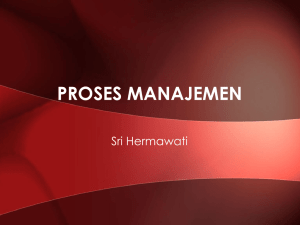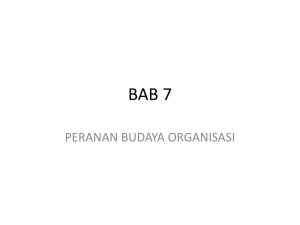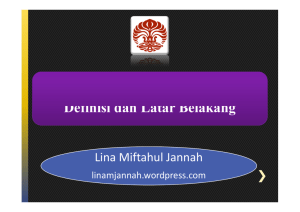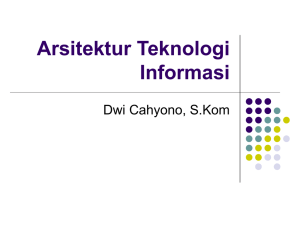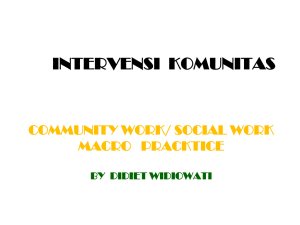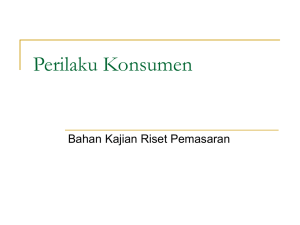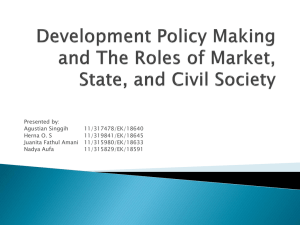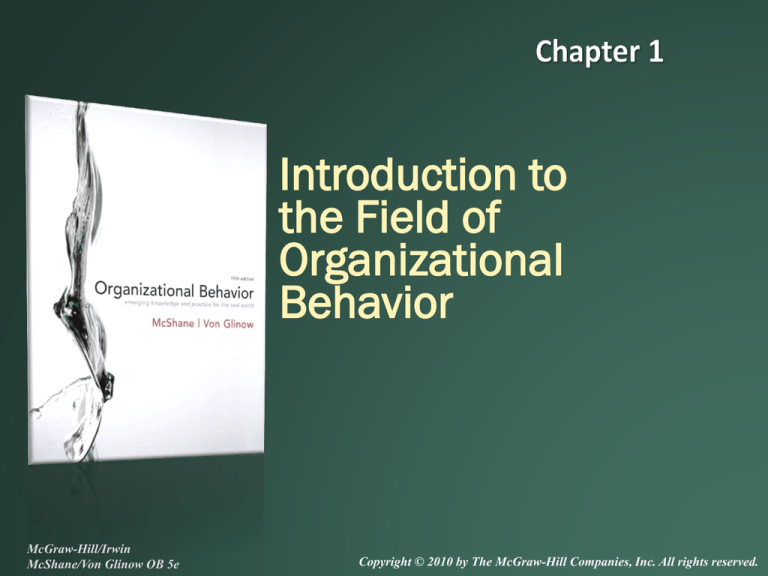
Introduction to
the Field of
Organizational
Behavior
McGraw-Hill/Irwin
McShane/Von Glinow OB 5e
Copyright © 2010 by The McGraw-Hill Companies, Inc. All rights reserved.
.
Apakah perilaku organisasi dan organisasi
itu?
Apa manfaat yang bisa kalian peroleh dari
mempelajari perilaku organisasi?
Jelaskan 4 perspektif dalam menjelaskan
“organizational effectiveness”
Apa saja tantangan yang dihadapi oleh
organisasi saat ini? Berikan penjelasan.
McShane/Von Glinow OB 5e
2
© 2010 The McGraw-Hill Companies, Inc. All rights reserved
Pixar Animation Studios
OB practices have helped
Pixar Animation Studios to
become the world’s most
successful animation studio
• Employee competencies
• People-centered
• Teamwork and org learning
• Constructive conflict
John Lassiter
Chief Creative Officer
of Pixar and Disney
1-3
Organizational Behavior and
Organizations
Organizational behavior
• The study of what people think,
feel, and do in and around
organizations
Organizations
• Groups of people who work
interdependently toward some
purpose
John Lassiter
Chief Creative Officer
of Pixar and Disney
1-4
OB Foundations
Distinct field around the 1940s
OB concepts discussed for more
than 2,000 years
Some pivotal scholars before OB
formed include:
• Max Weber
• Frederick Winslow Taylor
• Elton Mayo
• Chester Barnard (shown)
• Mary Parker Follett
Chester Barnard
1-5
Why Study OB?
Satisfy the need to understand and predict
Helps us to test personal theories
Influence behavior – get things done
OB improves an organization’s financial
health
OB is for everyone
1-6
Old Perspective of
Organizational Effectiveness
Goal oriented -- Effective firms
achieve their stated objectives
No longer accepted as indicator
of org effectiveness
• Could set easy goals
• Some goals too abstract to
evaluate
• Company might achieve wrong
goals
1-7
Four Perspectives of Organizational
Effectiveness
Open Systems Perspective
Organizational Learning Perspective
High-Performance WP Perspective
Stakeholder Perspective
NOTE: Need to consider all four perspectives
when assessing a company’s effectiveness
1-8
Open Systems Perspective
Organizations are complex systems that “live”
within (and depend upon) the external
environment
Effective organizations
• Maintain a close “fit” with changing conditions
• Transform inputs to outputs efficiently and flexibly
Open systems perspective lays the
foundation for the other three perspectives
or organizational effectiveness
1-9
Open Systems Perspective
Environment
Feedback
Feedback
Feedback
Feedback
1-10
Organizational Learning Perspective
An organization’s capacity to acquire, share,
use, and store valuable knowledge
Need to consider both stock and flow of
knowledge
• Stock: intellectual capital
• Flow: org learning processes of acquisition,
sharing, and use
1-11
Intellectual Capital
Human
Capital
Knowledge that people possess and
generate
Structural Capital
Knowledge captured in systems and
structures
Relationship
Capital
Value derived from satisfied customers,
reliable suppliers, etc.
1-12
Organizational Learning Processes
KNOWLEDGE
ACQUISITION
Extracting information
and ideas from its
environment as well
as through insight
KNOWLEDGE
SHARING
Distributing
knowledge
throughout the
organization
KNOWLEDGE
USE
Applying knowledge
to organizational
processes in ways
that improves the
organization’s
effectiveness
Examples in practice
Hiring skilled staff
Posting case
studies on intranet
Giving staff
freedom to try out
ideas
1-13
Organizational Memory
The storage and preservation of intellectual
capital
Retain intellectual capital by:
• Keeping knowledgeable employees
• Transferring knowledge to others
• Transferring human capital to structural capital
Successful companies also unlearn
1-14
High Performance Work Practices
(HPWPs)
HPWPs are internal systems and structures
that are associated with successful companies
1. Employees are competitive advantage
2. Value of employees increased through specific
practices.
3. Maximum benefit when org practices are bundled
1-15
High Performance Work Practices
No consensus, but HPWPs include:
• Employee involvement and job autonomy (and
their combination as self-directed teams).
• Employee competence (training, selection, etc.).
• Performance-based rewards
1-16
Stakeholder Perspective
Stakeholders: any entity who affects or is
affected by the firm’s objectives and actions
Personalizes the open systems perspective
Challenges with stakeholder perspective:
• Stakeholders have conflicting interests
• Firms have limited resources
1-17
Stakeholder Perspective
Lockheed Martin is rated by
engineering students as an
“ideal” employer
• Pays attention to its many
stakeholders
• Relies on values and ethics to
guide decisions
• Strong emphasis on corporate
social responsibility (e.g. photo
shows clean-up after hurricane
Katrina)
Lockheed Martin
1-18
Stakeholders: Values and Ethics
Values and ethics prioritize
stakeholder interests
Values
• Stable, evaluative beliefs, guide
preferences for outcomes or
courses of action in various
situations
Ethics
• Moral principles/values,
determine whether actions are
right/wrong and outcomes are
good or bad
Lockheed Martin
1-19
Stakeholders and CSR
Stakeholder perspective
includes corporate social
responsibility (CSR)
• Benefit society and environment
beyond the firm’s immediate
financial interests or legal
obligations
• Organization’s contract with
society
Triple bottom line
• Economy, society, environment
Lockheed Martin
1-20
Types of Individual Behavior
Task Performance
Organizational
Citizenship
Goal-directed behaviors under
person’s control
Contextual performance – cooperation
and helpfulness beyond required job
duties
more
1-21
Types of Individual Behavior
(con’t)
Counterproductive
Work Behaviors
Voluntary behaviors that potentially
harm the organization
Joining/staying with
the Organization
Agreeing to employment relationship;
remaining in that relationship
Maintaining Work
Attendance
Attending work at required times
1-22
Globalization
Economic, social, and cultural connectivity
with people in other parts of the world
Effects of globalization on organizations
• New structures
• Increasing diversity
• Increasing competitive pressures, intensification
1-23
Increasing Workforce Diversity
Surface-level diversity
• Observable demographic and other overt differences in
people (e.g. race, ethnicity, gender, age)
Deep-level diversity
• Differences in psychological characteristics (e.g.
personalities, beliefs, values, and attitudes)
• Example: Differences across age cohorts (e.g. Gen-Y)
Implications
• Leveraging the diversity advantage
• Also diversity challenges (e.g. teams, conflict)
• Ethical imperative of diversity
1-24
Employment Relationships
Work/life balance
• Minimizing conflict between work and nonwork
demands number one indicator of career success
Virtual work
• Using information technology to perform one’s job away
from the traditional physical workplace
• Telework – issues of replacing face time, clarifying
employment expectations
1-25
Organizational Behavior Anchors
Multidisciplinary anchor
• Many OB concepts adopted from other disciplines
• OB develops its own theories, but scans other fields
Systematic research anchor
• OB researchers rely on scientific method
• Should apply evidence-based management, but…
- Bombarded with theories and models
- Challenge translating general theories to specific situations
- Swayed by consultant marketing
- Perceptual biases -- ignoring evidence contrary to our beliefs
1-26
Organizational Behavior Anchors
(con’t)
Contingency anchor
• A particular action may have different consequences in
different situations
• Need to diagnose the situation and select best strategy
under those conditions
Multiple levels of analysis anchor
• Individual, team, organizational level of analysis
• OB topics usually relevant at all three levels of analysis
1-27
Perilaku Organisasi (Robbins)
PERILAKU ORGANISASI
Mempelajari
perilaku manusia
sebagai individu,
sebagai anggota
kelompok (group),
dan sebagai
anggota organisasi
secara keseluruhan
dalam kaitannya
dengan efektivitas
mencapai tujuan
organisasi
Harapan
Jika tiap INDIVIDU berperilaku atau bekerja
efektif dalam mencapai tujuannya, maka
kelompok dimana ia menjadi anggota, juga
menjadi efektif dalam mencapai tujuan, jika
tiap-tiap KELOMPOK dalam organisasi juga
efektif dalam mencapai tujuan, maka
ORGANISASI itu juga akan menjadi efektif
dalam mencapai tujuan organisasi.
INDIVIDU KELOMPOK
ORGANISASI
TUJUAN PRAKTIS PERILAKU
ORGANISASI
untuk memperlancar usaha
pencapaian tujuan organisasi
Framing the Study of OB
The Field of OB
Individual Differences & Work
Behavior
Group Behavior & Interpersonal
Influence
Organizational Processes
Organizational Design, Change &
Innovation
DISIPLIN ILMU PERILAKU ORGANISASI
(Interdisipliner)
Dalam mengelola organisasi, berbagai pandangan atau
disiplin ilmu digunakan bersama untuk membentuk
suatu satuan yang disebut disiplin perilaku
organisasional.
Ilmu yang berkontribusi pada OB :
Psikologi
Psikologi Sosial
Antropologi
Ekonomi, politik, dan sejarah
Dampak Berbagai Disiplin Ilmu
Dari berbagai disiplin ilmu yang memberi sumbangan
terhadap perilaku organisasi, kita menjadi lebih
memahami bahwa perilaku manusia itu ada sebab dan
akibatnya.
Dari berbagi penelitian, terungkap bahwa perilaku itu:
Ada sebabnya (dari luar atau dari dalam diri
seseorang)
Ada akibatnya (bagi dirinya maupun bagi orang lain)
Ada motivasinya
Perilaku yang dapat dipantau itu dapat diukur
Perilaku yang meskipun tidak dapat dipantau, seperti
berpikir, berpersepsi, dan bersikap, ternyata sangat
penting dalam kaitannya dengan pencapaian tujuan
Basic OB
Model,
Stage II
E X H I B I T 1-7
MODEL PERILAKU ORGANISASI ROBBINS
Model “3-LEVEL” (S.P.ROBBINS)
Dalam mempelajari perilaku manusia dalam
organisasi sebetulnya dapat dibagi dalam 3 tingkatan
(level), yaitu :
Tingkatan INDIVIDU
Yang dibahas pada tingkatan ini, antara lain :
Karakteristik yang dibawa oleh individu ke dalam
organisasi, seperti misalnya persepsi,
kepribadian, motivasi.
Hal-hal dalam organisasi, yang bisa
mempengaruhi sikap, persepsi, motivasi, dan
kepuasan kerja individu.
Kepribadian dan implikasinya pada perilaku dan
performansi di tempat kerja.
MODEL PERILAKU ORGANISASI ROBBINS
• Tingkatan KELOMPOK
Pokok bahasan pada tingkatan ini terutama mengenai
Dinamika Kelompok, termasuk di dalamnya antara lain :
uraian tentang pembentukan kelompok, proses-proses
yang terjadi dalam kelompok, keterpaduan kelompok,
kompetisi dan konflik.
• Tingkatan ORGANISASI
Yang dibahas dalam tingkatan ini, antara lain adalah :
bagaimana pengaruh dari ukuran organisasi, iklim
organisasi, kebijakan organisasi, tingkat hirarki dalam
organisasi, terhadap perilaku dan performansi individu
dalam organisasi tersebut
Tantangan dan Peluang Perilaku
Organisasi
Improving People Skills
Empowering People
Stimulating Innovation and Change
Coping with “Temporariness”
Working in Networked Organizations
Helping Employees Balance Work/Life
Conflicts
Improving Ethical Behavior
Managing People

